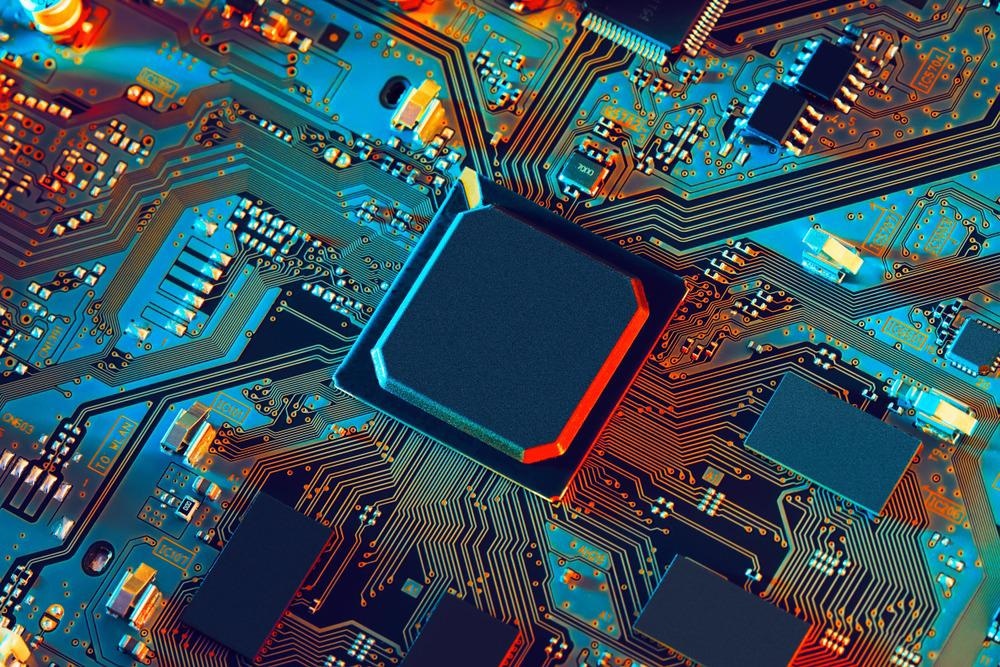A group of researchers recently published a paper in the journal ACS Applied Materials and Interfaces that demonstrated the effectiveness of polyvinylpyrrolidone (PVP)-functionalized eutectic gallium indium (EGaIn) composites as printable self-activated liquid metal stretchable conductors.

Study: Printable Self-Activated Liquid Metal Stretchable Conductors from Polyvinylpyrrolidone-Functionalized Eutectic Gallium Indium Composites. Image Credit: raigvi/Shutterstock.com
Background
Stretchable electronic circuits are crucial in an extensive range of advanced electronics applications such as wearable technologies and soft robots.
Until now, printable composite conductors containing different types of conductive fillers were considered for attaining excellent stretchability and high electrical conductance.
Among those conductive fillers, liquid metal particles were considered as the most suitable option that can effectively meet the prerequisites.
However, a mechanical activation process is still required to create interconnected liquid channels by rupturing oxide shells around EGaIn particles inside elastomeric polymers.
In this study, researchers investigated the suitability of PVP-functionalized EGaIn particles as a stretchable printable conductor that does not require mechanical activation.
The Study
EGaIn particles were synthesized by sonicating a mixture of ethanol and EGaIn for 2 min at room temperature. They were then collected by centrifugation of the mixture for 15 min at 1500 rpm.
Subsequently, the collected EGaIn particles were mixed with PVP and dissolved in isopropyl alcohol.
The PVP and EGaIn content in the mixture was 0.5 and 93.7 wt % respectively.
A mixture of a cross-linking agent and a polydimethylsiloxane (PDMS) prepolymer was added to the above mixture and all contents were mixed using a planetary centrifugal mixer.
The molecular weights of the PVP used in the study were 10,000 and 1,300,000 g/mol.
A programmable dispenser printer was employed to print the PVP-added EGaIn (P-EGaIn) pastes on octadecyl trichlorosilane (OTS)-treated hydrophobic glass substrates at a printing speed of 1mm/s and air pressure of 300 kPa.
Thermal treatment was performed for 6 h at 120 oC to complete the cross-linking reactions of PDMS prepolymers.
Ethoxylated polyethylenimine (EPIE)-PDMS, an elastomer with soft, sticky, and stretchable characteristics was prepared by mixing the EPIE and PDMS mixture, and then the resultant mixture was poured on the P-EGaIn patterns and cured for 8 h at 50 oC. Subsequently, the P-GaIn conductor embedded in the EPIE-PDMS films were delaminated from the OTS-treated glass substrates.
LCE films were prepared by mixing 4-(N-maleimido) benzyl trimethylammonium iodide, 4-bis-[4-(3-acryloyloxypropyloxy) benzoyloxy]-2-methylbenzene, 2,2 ′ (ethylenedioxy) diethanethiol, pentaerythritol tetrakis(3-mercaptopropionate), dipropyl amine, and 2,2-dimethoxy-2-phenyl acetophenone, and then dissolving the resultant mixture in dichloromethane (DCM), and finally transferring the mixture to rectangular-shaped Teflon molds.
A scanning electron microscope was used to observe the shapes and sizes of EGaIn morphologies and particles of the printed stretchable conductors, while X-ray photoelectron spectroscopy (XPS) was utilized to perform the chemical structural analysis of EGaIn particles.
A digital source meter with a four-probe measurement setup was employed to measure the resistance of the conductive layers of the EGaIn liquid metal, while a TA Instruments Q20 was used to obtain the differential scanning calorimetry (DSC) curve at a heating rate of 10 oC/min.
Observations
The study results showed that the average diameter of EGaIn particles synthesized from the probe sonication technique was 1.2 μm and these particles were surrounded by thermodynamically stable oxide shells.
PVP-free EGaIn particles were acting as insulators even at 100% strain, indicating that the application of tensile stress was ineffective in rupturing the oxide shell layer of EGaIn particles in the composite layer.
However, the P-EGaIn composite layer displayed excellent conductivity and a gradual decline in resistance from 0% to 100% strain when 0.5 wt % PVP was added to EGaIn particles.
The electrical conductivity and resistance of the P-EGaIn composite layer were 1065 S/cm and 4.1 Ω/cm, respectively, without involving any stress-related mechanical activation process, indicating the formation of conductive liquid channels inside the elastomeric matrix by a delamination procedure and thermal treatment below 120 oC.
However, the conductivity of the layer was increased to 8372 S/cm, and the resistance decreased to 1.1 Ω/cm after it was stretched to 100% strain.
In the P-EGaIn stretchable conductors where the conductive channels can be reconfigured under stretching conditions, the change in resistance was only 0.53 from no strain to 100% strain conditions, indicating invariant electrical resistance under stretching conditions.
Invariant electrical resistance is necessary for designing integrated stretchable circuits using highly conductive printed interconnectors.
The XPS spectrum showed that 51% of monomer units are bound to the surface of P-EGaIn particles when the particles were functionalized by the PVP with a molecular weight of 10,000 g/mol, while only 19% of monomer units were bound to the surface when the molecular weight of PVP was 1,300,000 g/mol.
Thus, the optimum p-EGaIn composite paste was formulated by including equal weights of PVPs with different molecular weights of 1,300,000 and 10,000 g/mol.
The LCE film contracted when the temperatures of the P-EGaIn heating unit were increased above 45 oC.
During the 60,000-cycle test for the 0.5 wt % of P-EGaIn at a strain of 75%, no notable degradation of the electrical property of P-EGaIn was observed and the variations in resistance in terms of strain-level were hysteresis-free. The invariant resistance change was 0.92 after 60,000 cycle tests.
Taken together, the findings of this study demonstrated that self-activated printable stretchable conductors synthesized from P-EGaIn are suitable for different kinds of stretchable electronics applications.
Continue reading: Piezoelectric Materials and Piezo Response Force Microscopy (PFM)
Reference
Jeong, S., Choi, Y., Jo, Y. et al. (2022) Printable Self-Activated Liquid Metal Stretchable Conductors from Polyvinylpyrrolidone-Functionalized Eutectic Gallium Indium Composites. ACS Applied Materials and Interfaces .Available at: https://doi.org/10.1021/acsami.1c20185.
Disclaimer: The views expressed here are those of the author expressed in their private capacity and do not necessarily represent the views of AZoM.com Limited T/A AZoNetwork the owner and operator of this website. This disclaimer forms part of the Terms and conditions of use of this website.